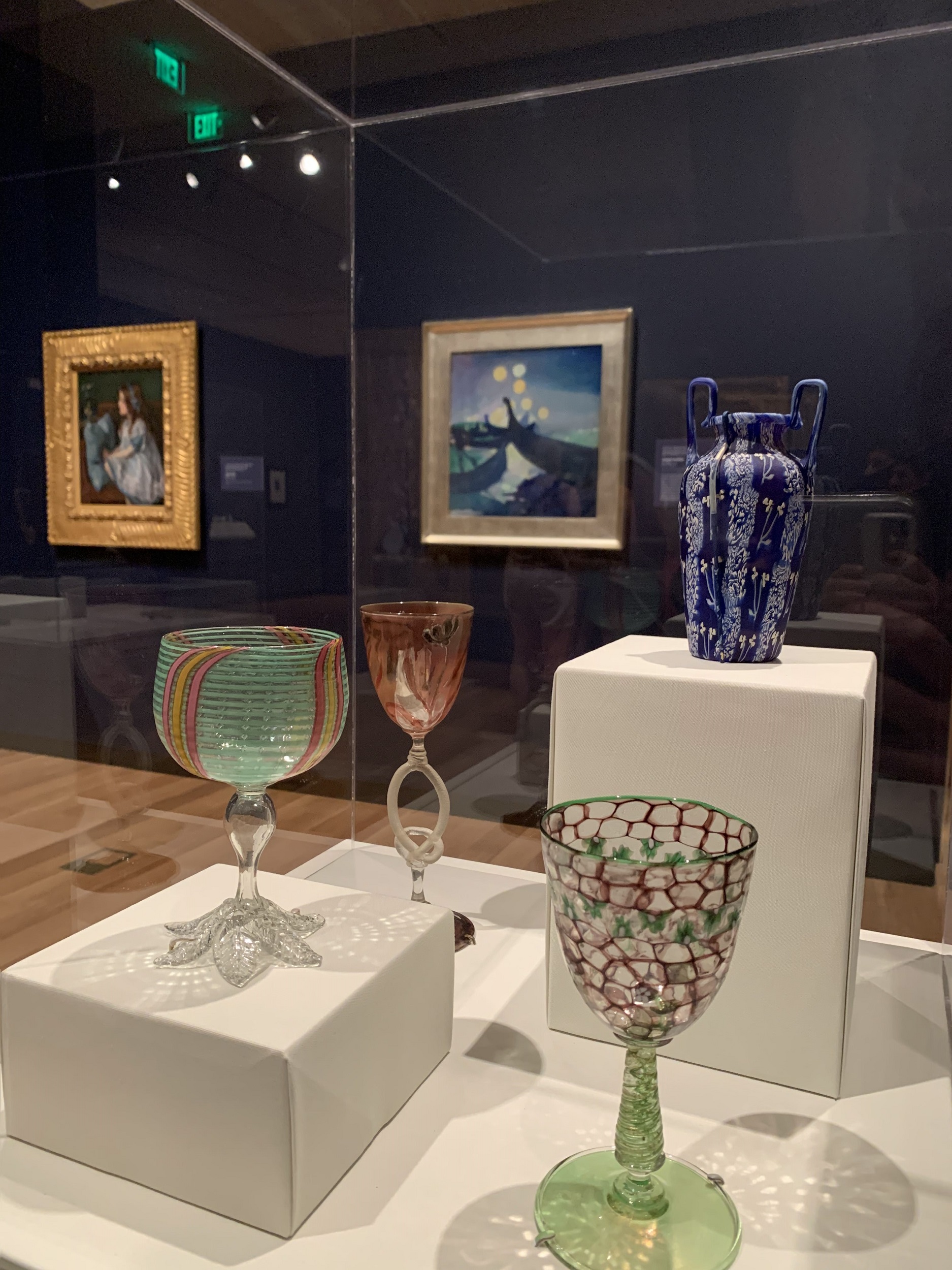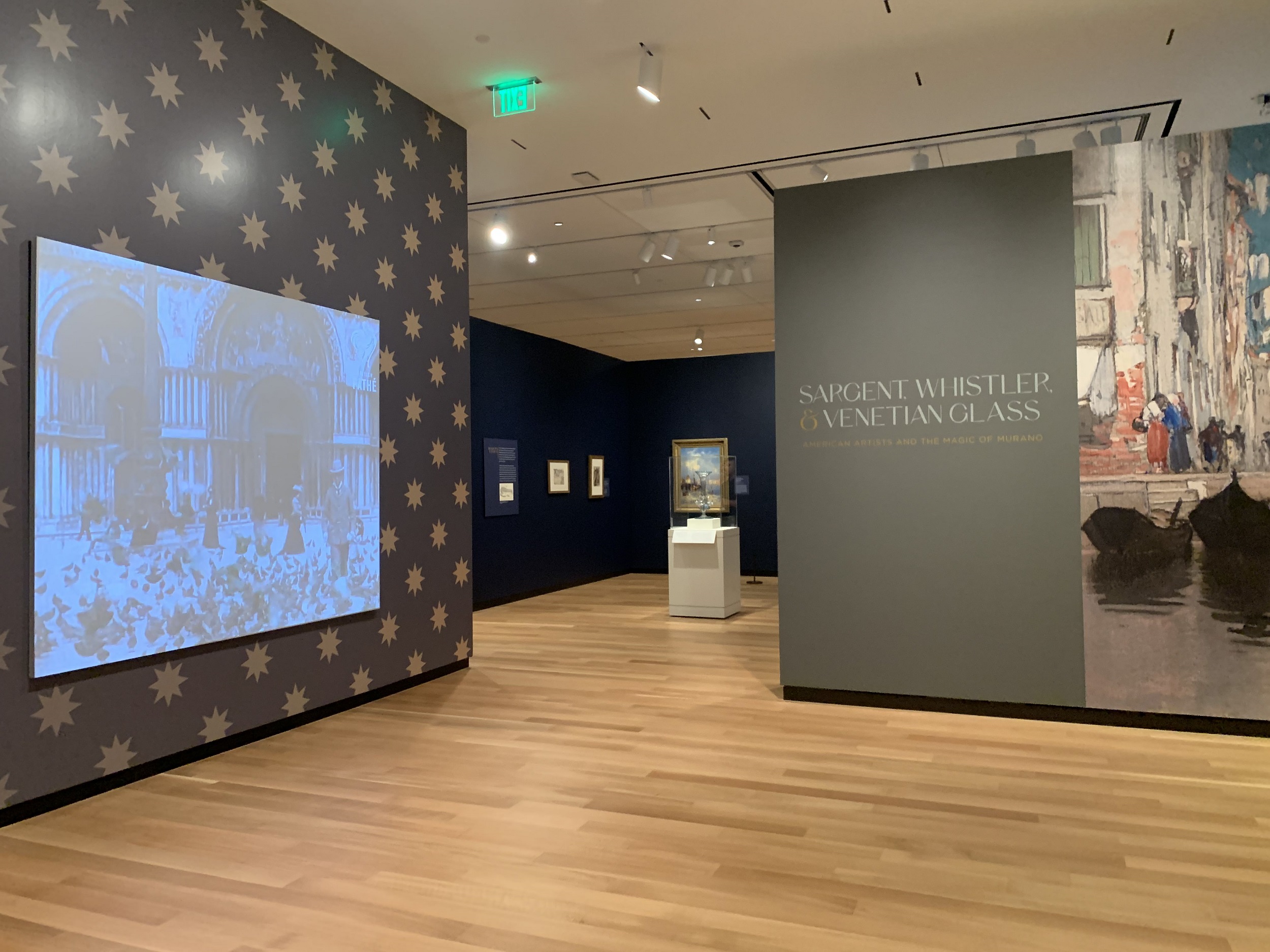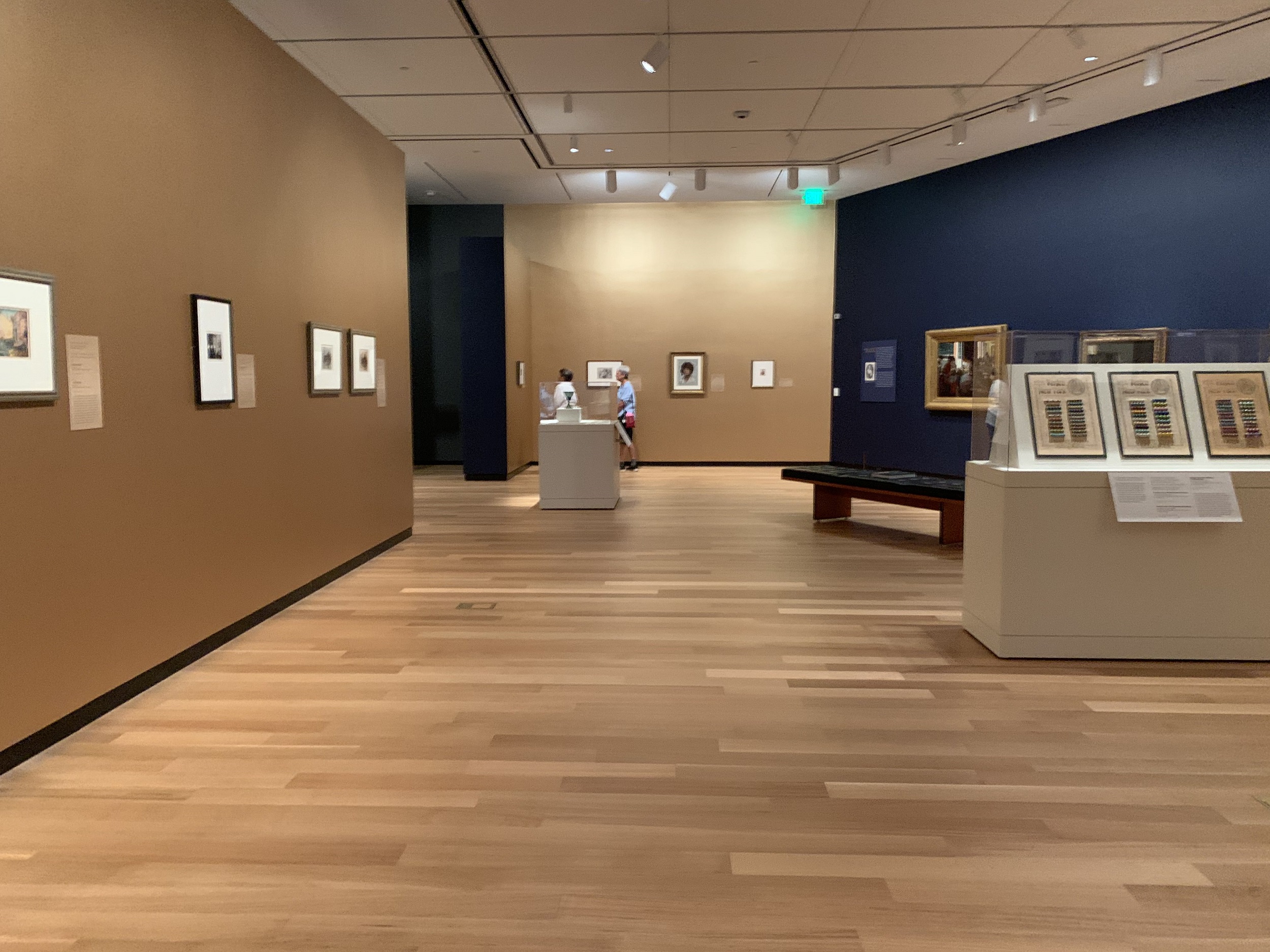Sargent, Whistler & Venetian Glass: American Artists and the Magic of Murano
PDF: Burns, review of Sargent, Whistler & Venetian Glass
Curated by: Crawford Alexander Mann III
Exhibition schedule: Smithsonian American Art Museum, Washington, DC, October 8, 2021–May 8, 2022; Amon Carter Museum of American Art, Fort Worth, TX, June 25–September 11, 2022; Mystic Seaport Museum, Mystic, CT, October 15, 2022–February 27, 2023
Exhibition catalogue: Crawford Alexander Mann III, ed., Sargent, Whistler & Venetian Glass: American Artists and the Magic of Murano, exh. cat. Washington, DC: Smithsonian American Art Museum, in association with Princeton University Press, 2021. 336 pp.; 182 color illus.; 35 b/w illus. Cloth: $65.00 (ISBN: 978–0691222677).

How do you see a painting through a veil of glass (fig. 1)? In the multimedia exhibition Sargent, Whistler & Venetian Glass: American Artists and the Magic of Murano—organized by Crawford Alexander Mann III, former Curator of Prints and Drawings at the Smithsonian American Art Museum, and adapted for the Amon Carter Museum of American Art by Margaret (Maggie) Adler, where I visited the show—museumgoers were asked to consider fantasies of place and culture through painted representations of Venice alongside examples of Venetian glass that percolated through US art collections in the late nineteenth and early twentieth centuries.1 The exhibition attests to the depth of research about the glass revival movement in Venice in the period after Italian unification, the prolific acquisition of such objects by US collectors, and the circulation of white US artists in Veneto. The material offers an opportunity to consider the role of tourism in shaping art and tastemaking, to probe the meaning of handicraft in a period of industrialization, and to encourage a deep dive into materiality. The exhibition’s attention to privileged US mobilities giving access to Venice and enabling interest in Venetian glass is a throughline, while the implications of labor and class, as well as the possibility of material aesthetic dialogue between glass making and painting, remain opaque.
Installed in Fort Worth against walls of vibrant, saturated colors like mustard yellow, deep gray, azure, and sapphire blue, the paintings and glasswork alike seemed to glow in the six galleries of the exhibition. Examples of ancient Venetian glass encouraged attention to how fin de siècle Venetian glassmakers self-consciously reinvigorated earlier traditions and continued to adapt artistic practice. Doubling down on the tourist experience, the exhibition opened with a video of St. Mark’s Square in Venice as an iconic space (fig. 2). John Singer Sargent’s A Venetian Woman (1882; Cincinnati Art Museum), cradling glass canes in her arms, beckoned entry into the first gallery, which held both paintings and glass.

The second, larger gallery, with its lighter blue walls, configured Venice as a space that drew heightened interest from US artists, and it presented a selection of tourist and expatriate landscapes and genre scenes of Venice by Julius LeBlanc Stewart, Hermann Dudley Murphy, James Abbott McNeill Whistler, Frank Duveneck, and others (fig. 3). Vitrines in the center of the gallery offered an exemplary array of both ancient and modern blown art glass, including works by Vincenzo Moretti and other Venetian workshops.

The third gallery, featuring a mustard-colored backdrop (fig. 4), held a stunning collection of bead trading cards from the Illinois State Museum, prints of the Venetian landscape and its people, a freestanding video monitor with historical films about glass production, and cases with samples of Venetian lace with intermedia links made to glass designs. A deep-blue accent wall bore canonical examples of US artists’ paintings produced in Venice, such as Sargent’s Leaving Church, Campo San Canciano, Venice (c. 1882; Collection of Marie and Hugh Halff) and Venetian Glass Workers (c. 1880–82; Art Institute of Chicago).
The fourth gallery focused on mosaic production and the concurrent renovation of Saint Mark’s Basilica in Venice, as well as examples of ancient glass. The back wall featured a fantastic, locally produced, step-by-step didactic display titled “How is Glass Made?,” developed by the SiNaCa Studios School of Glass and Gallery in Fort Worth. It charted glass production with samples of clear glass to materialize each step.
The fifth gallery traced the influence of interest in Venetian glass in the United States, including examples of the Stanford University mosaics produced by Salviati & Co., a luminous Maxfield Parrish painting intended for illustration, and appropriations of gondola imagery by Winslow Homer and Arthur Beecher Carles. With midnight-blue walls, the final gallery vestibule exhibited additional Stanford mosaics and paintings by Samuel Caryl Coleman and Henry Alexander that render Venetian glass objects and tourist sites.
The signage of the exhibition presented the visitor with some challenges. Located in the traveling venue of the Amon Carter, the exhibition seemed awkwardly scaled for the space because many of the sections seemed to wrap between rooms. The placement of the section labels confused how the show was parsed. For example, the wall label that discussed the lace revival, visible at the far left of the dark blue wall, was tucked in the far corner of a gallery where it did not clearly refer to the objects around it (fig. 4). Instead, most of the paintings on the blue wall to its right were Sargent’s representations of glass production and Venetian street views; the objects on the wall to the panel’s left included Duveneck’s portrait Gypsy Boy (1885; Collection of Jane Joel Knox, promised gift to the Virginia Museum of Fine Arts). In the next gallery, the viewer may have wondered: How does Pinckney Marcius-Simons’s painting of Antonio Canova producing a butter sculpture (1885; Chrysler Museum of Art) relate to lace or mosaic production? Other display choices also gave a muddled sense of order. The Stanford mosaics were divided across the last full-sized gallery and the exit vestibule. Paintings produced outside of the United States, such as by Robert Frederick Blum and Samuel Colman, were in a gallery titled “From Murano to America” that announced its focus on the influence of Venetian glass back in the United States.

The inclusion of additional signage and greater integration across media may have helped clarify the exhibition’s arguments and goals. In scale and luminosity, the oil paintings tended to outshine the prints, which are more monochromatic and relatively diminutive in scale. In a section titled “Intimate Views and Smaller Souvenirs,” prints by women artists working in Venice, such as Ellen Day Hale, floated unmoored alongside small US-Japanese color woodblock print collaborations between Andrew Kay Womrath and Yoshijiro Urushibara, hung with wide spacing between the works. One glass case in the fourth gallery of mainly ancient glass lacked numbers to identify the objects. These display challenges reinscribed a hierarchy of media in a space that seemed otherwise to strive for an immersive multimedia environment. Often, the art glass pieces were placed in cases at the center of the room, which allowed them to be viewed in the round, but this decision also reinforced a differential hierarchy between the paintings and the glass objects. I also noted some visitors walking only the exterior perimeter, observing, it seemed, only the paintings and prints. While the catalogue notes a desire to recover “intertwined stories” connecting decorative and fine arts, the installation did not consistently support this agenda.2
Also unclear was the relationship between the painters and their human subjects. The exhibition shied away from considerations of the politics of labor and poverty in the face of the privilege of elite tourism, as seen in Duveneck’s Gypsy Boy and Whistler’s The Beggars (First Venice Set) (1879–80; National Gallery of Art, Washington, DC). The accompanying label for the Whistler print described “working class figures who loiter or perform everyday tasks,” claiming they function by “adding local color” and framing the scale of the represented space. What are the implications of this pronounced aestheticization of labor in the context of what the label noted is a moment of Whistler’s own privation, as he produced these objects hoping to market them to cover his debt? What are the gender dynamics embedded in Whistler’s and Sargent’s renderings of lower-class women? Such questions are likewise avoided in Stephanie Mayer Heydt’s catalogue essay, which discusses these works.3 Labor percolates through paintings by Blum and Sargent with their representations of individuals engaged in making lace, beadwork, and glass. How does this focus inflect the makers’ self-perception as laborers for a group of mostly privileged Northeastern and expatriate painters? Is there a dialogue or a hierarchy between artist and artisan? How do the paintings operate both as symbols of observer detachment and also as forms of immersion and escapism?
Further questions arise: What about Italian painters within this exchange? Was the US colony in Venice self-segregated or segregated by language? What are the politics of US interest in, and travel to, Venice and Italy around 1900? How did the vision of the place and its art production square with the work of Italian contemporaries? What is the relationship of the Veneto with the larger regional politics of the Risorgimento, a topic addressed deep in the catalogue but not raised in detail by the exhibition’s interpretive texts?4 Did the latter-day grand tour by US artists perceive Venice as cultural backwater or as an icon of civilization? Other questions arise around the production of opalescent and other forms of glass in the United States. Was there a dialogue involved with such practices that could expand the narrative of exchange beyond US painting and Venetian glass? Examples by artists such as John La Farge and Louis Comfort Tiffany would have been particularly insightful.
The exhibition tiptoed toward but then sidestepped consideration of the possible dialogue between Native American artists and Venetian glass through the enduring circulation of glass beads across Turtle Island. The topic was noted briefly in the third gallery (fig. 4). The catalogue, however, claims it is beyond the scope of the project, and the authors neglect to point out rich scholarship on this topic.5 The inclusion of a few examples of historical Native American regalia produced with Venetian beads might have contributed to a more inclusive and expansive definition of American art, undergirding not only the role of Native Americans in the history of American art but also drawing attention to the intersections between glass and the politics of power. In the same period as Sargent’s, Blum’s, and Duveneck’s luminous Venetian paintings, beading within the Dakota and Lakota nations in the American Plains reached new levels of complexity as vests, dresses, and even suitcases were entirely covered in beads. Native artists in the northern plains began to introduce more figurative designs alongside long-standing geometric patterns in the face of the most restrictive period of forced assimilation.6 An inclusion of Native American art would have also provided a greater gender balance to the exhibition, since most Plains beadworkers in the late nineteenth century were women. Further, integrating this material would have afforded an opportunity to draw attention to the perceptual experience of glass: in the same way that the uneven surfaces of mosaics catch the light as the viewer moves, beadwork glints dynamically as its wearer takes steps.
The exhibition also elided what for me would have been the most powerful intervention of this stunning multimedia display: a meditation on the aesthetic dialogues between painting practice and resplendent glass. Indeed, many of the objects in the exhibition reveal that this dialogue involves not only tastemaking but also materiality. The exhibition and its catalogue leaned on glass as an iconographic symbol and object of collectors’ desire more than an aesthetic model for luminosity, saturation, and glow in painting. But the paintings of the “magic of Murano” seem to support this reading with their pops of color, even amid somber palettes. For example, Heydt notes the “muted ochre, beige, brown and black” in a painting like Sargent’s A Venetian Interior (c. 1880–82; Sterling and Francine Clark Art Institute). However, in this representation of a cavernous and dark hallway, what stands out is the vibrant light forcing its way through the back window and the swaths of red along the figures at the right side of the composition, as well as the sea-green dress of the figure in the left foreground.7 The staccato brushwork and coloration within the obscured dark pictures operate, to my eye, subtly akin to mosaic. Likewise, the iridescent display of color rendered by loose strokes in Blum’s Venetian Lacemakers (1887; Cincinnati Art Museum) also evokes mosaic. In this vein, the aesthetic parallel drawn between Maurice Prendergast’s mosaic Fiesta Grand Canal, Venice (c. 1899; Williams College Museum of Art) and his painting Ponte della Paglia (c. 1898; Phillips Collection) might extend to other artists’ experiments with oil painting in dialogue with the medium of mosaic as well. Can we observe, in short, an aesthetic of glass being translated from one malleable and viscous medium to another?
These visual qualities are—for the important glass collector, discussant, and critic of American art, James Jackson Jarves—nothing short of transcendent. He enthuses, in quotations leveraged more in the catalogue than the exhibition text, about glass’s ability “to invent something so bizarre, ethereal, light, imaginative or so splendid, fascinating and original in combinations of color and design, as to captivate both the senses and understanding, and lead them rejoicing into faraway regions of the possibilities of an ideal existence.”8 Jarves extols Venetian glass’s role to “administer to the human craving for beauty, perfection, the supreme aesthetic ideal of the moment, restless, ever-changing, and never satisfied, because beauty is rooted in the infinite.”9 His language could easily have been mapped into contemporaneous conversations about the visual experience and goals of modernism. The curators might have pushed the parallels between motifs in glass design and the development of abstraction, further driving home the centrality of the Venetian glass revival to US art practice. The exhibition only passively suggested an aesthetic correspondence between Venetian glass and the suggestive abstraction of Carles’s Venetian Gondolas (c. 1909; Estate of Robert and Linda Wueste; see fig. 1), which is so suggestively luminous that it invites the viewer to squint upon perceiving it, or the textured, shimmering, and pearlescent rendering of Venetian ancient glass in Alexander’s Cyprus Glass (1894; Collection of David Mamet and Rebecca Pidgeon).
The luscious materiality of the objects on display allowed viewers to fulfill a type of armchair mobility, perhaps felt strongly after rampant physical stagnation during the COVID-19 pandemic.10 The exhibition did deliver on this front. It provided access to an aesthetic experience that one period critic called “fairy forms and rainbow hues,” even if the politics and implications of this visual trade were not explicitly articulated.11
Cite this article: Emily C. Burns, review of Sargent, Whistler & Venetian Glass: American Artists and the Magic of Murano, Amon Carter Museum of American Art, Panorama: Journal of the Association of Historians of American Art 8, no. 2 (Fall 2022), https://doi.org/10.24926/24716839.15405.
Notes
With thanks to Jessica Skwire Routhier, Annika Fisher, Mora Beauchamp-Byrd, and Caroline Riley for their edits on this text and to my colleagues at the Amon Carter Museum of American Art.
- Emily C. Burns is a Research Notes editor for Panorama. ↵
- Crawford Alexander Mann III, introduction to Sargent, Whistler & Venetian Glass: American Artists and the Magic of Murano, ed. Crawford Alexander Mann III (Washington, DC: Smithsonian American Art Museum, in association with Princeton University Press, 2021), 32. ↵
- Stephanie Mayer Heydt, “‘Where Have Titian’s Beauties Gone?’ Sargent and Whistler on the Streets of Venice,” in Mann, Sargent, Whistler & Venetian Glass, 150–51, 157–59, 165. ↵
- Crawford Alexander Mann III, “Sparks of Genius: American Art and the Appeal of Modern Venetian Glass,” in Mann, Sargent, Whistler & Venetian Glass, 231. ↵
- Mann, introduction to Sargent, Whistler & Venetian Glass, 37, 57n17. Key sources include Marsha C. Bol, The Art and Tradition of Beadwork (Layton, UT: Gibbs Smith, 2018); Lois S. Dubin, Floral Journey: Native North American Beadwork (Los Angeles: Autry National Center of the American West, 2014). ↵
- See, for instance, Nellie Two Bears Gates (Gathering of Cloud Woman; Iháƞktȟuƞwaƞna Dakhóta)’s valise (188–1910; Minneapolis Institute of Art), https://collections.artsmia.org/art/109856/suitcase-nellie-two-bear-gates. On the flourishing of dense beading in the Reservation period, see Marsha Clift Bol, “Lakota Beaded Costume of the Early Reservation Era,” in Arts of Africa, Oceania and the Americas: Selected Readings, ed. Janet Catherine Berlo and Lee Anne Wilson (Englewood Cliffs, NJ: Prentice Hall, 1993), 363–70; Marsha Clift Bol, “Lakota Women’s Artistic Strategies in Support of the Social System,” American Indian Culture and Research Journal 9, no. 1 (1985): 33–51. ↵
- Heydt, “‘Where Have Titian’s Beauties Gone?,’” 154. ↵
- James Jackson Jarves, “Ancient and Modern Venetian Glass of Murano,” Harper’s New Monthly Magazine 64, no. 380 (January 1882): 186, quoted in Mann, introduction to Sargent, Whistler & Venetian Glass, 39. ↵
- Jarves, “Ancient and Modern Venetian Glass of Murano,” 187, quoted in Melody Barnett Deusner, “Murano Glass and its Collectors in Aesthetic America,” in Mann, Sargent, Whistler & Venetian Glass, 71. ↵
- Stephanie Stebich, “Director’s Foreword,” in Mann, Sargent, Whistler & Venetian Glass, 23. ↵
- “Blowing a Wine-Glass,” Manufacturer and Builder 1, no. 5 (June 1869): 169, quoted in Mann, “Sparks of Genius,” 219. ↵
About the Author(s): Emily C. Burns is Director of the Charles M. Russell Center for the Study of Art of the American West, School of Visual Art, University of Oklahoma

